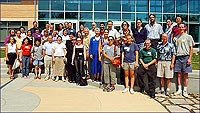 |
The Legacy Preference
by Mathew Vella '03
A core group of legacy students reinforces Oberlin's
academic culture and value system from generation to generation,
says Alumni Association Director Midge Wood Brittingham '60. "Having
a child attend Oberlin increases the parent's involvement and demonstrates
the continuing excellence of the College."
Given that, to what extent should colleges go to attract legacies?
President Bush's strong anti-affirmative action stance in the University
of Michigan's Supreme Court case has been met with criticism. In
arguments leveled directly at Bush, critics have cast legacies as
an alternative form of unethical preferencing by college admissions
offices. Now that the Court is considering whether minority applicants
are taking the rightful spots of more qualified whites, some supporters
of race-conscious admissions are mounting a counteroffensive. They
hold that it is the preferential treatment afforded some applicants
because of their parents' wealth or college affiliation that is
truly unfair.
In recent years, the large public university systems of Georgia
and California have dropped preferences for legacies and other VIP
applicants. No highly selective private college has followed suit,
however, in large part because the economic benefit of admitting
such students is so great.
At Oberlin, says Associate Director of Admissions Leslie Braat,
"a legacy applicant may benefit through the admissions process
if that student is 'on the bubble' between an acceptance and the
decision to waitlist, meaning that we would probably admit. But
someone who is inadmissible in our applicant pool would not be extended
an offer of admission solely because of a legacy status."
Legacies represent 4 to 5 percent of Oberlin's entering class annually,
a figure consistent with other small liberal arts colleges, says
Dean of Admissions and Financial Aid Debra Chermonte. "Our
office engages in several activities to reach out to prospective
students with legacy ties," she says.
"We begin each admissions cycle soliciting alumni referrals
of prospective students--especially those with Oberlin family roots."
Throughout the year, admissions officers arrange campus visits for
legacy students and their parents; the office also hosts college
planning workshops during Reunion Weekend each spring.
Although legacy numbers among new Oberlin students last fall were
down by five in comparison to 39 in 2001, this year's crop is rich
in tradition. At least two first-year students have second-generation
ties to the College, and three have had family members trickle in
on an almost steady basis since the early 1920s.
Page 1
| 2 | 3
| 4 | 5
of Family Tree, Oberlin Roots
|
 |


![[cover story] Fury and the Sound](graphics/nav_fury.gif)
